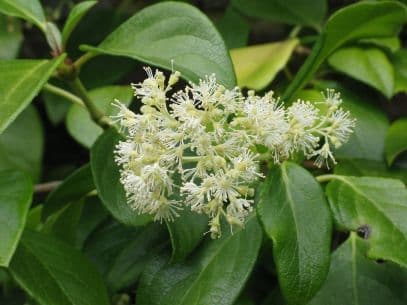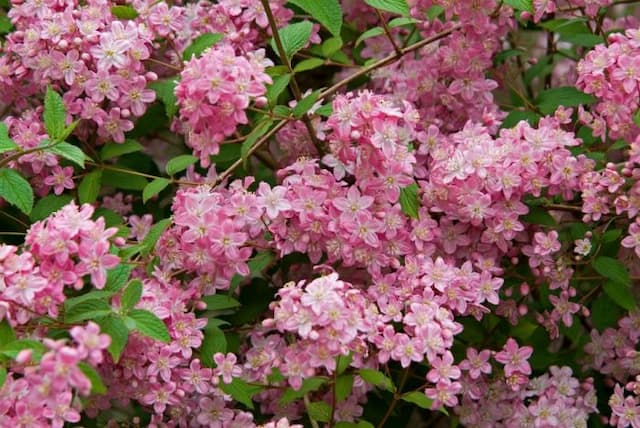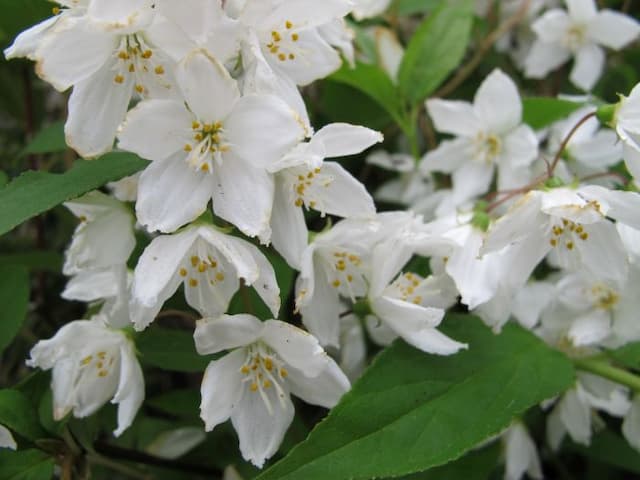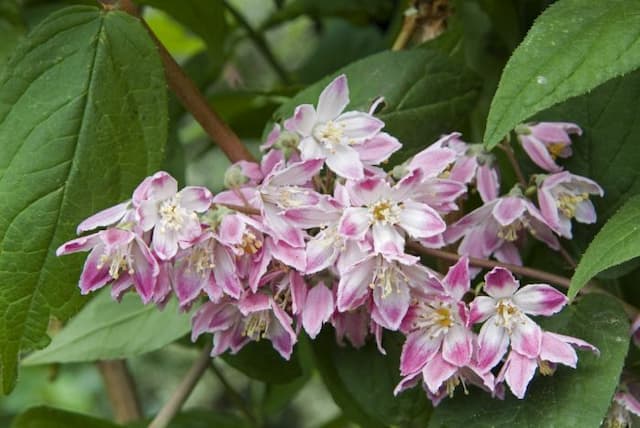Mountain Hydrangea Hydrangea serrata 'Shirofuji' (L/d)

ABOUT
Hydrangea serrata 'Shirofuji' is distinguished by its rounded clusters of small flowers, with a creamy white hue that offers a serene and soothing vibe to any garden setting. The flower heads of this plant feature a lacecap formation, which consists of a flat, circular arrangement where the central tiny buds are encircled by larger, ornamental flowers. The tiny, fertile flowers in the center are often overlooked, yet they contribute significantly to the overall texture of the bloom. The larger flowers on the edge of the clusters possess a delicate charm, enhancing the intricate design of the lacecap appearance. The leaves of 'Shirofuji' are broadly ovate, with pointed tips and serrated edges that give them a tooth-like pattern, embodying the serrated moniker in its name. They have a rich green color that forms an attractive backdrop for the contrasting white flowers. The foliage may also display a subtle color transformation as the seasons change, adding to the visual interest of the plant. This plant's branches grow in a way that allows it to become a dense, bushy shrub. The stems and branches can be sturdy and contribute to the overall shape and structure of the hydrangea. The pleasant combination of its flowers and foliage makes the 'Shirofuji' a popular choice for gardeners who are fond of ornamental shrubs that provide a long-lasting display of blooms throughout their flowering season. It is commonly appreciated for its ability to brighten shaded areas and its use in various landscape designs, from hedges to standalone specimens.
About this plant
 Names
NamesFamily
Hydrangeaceae.
Synonyms
Mountain Hydrangea, Tea of Heaven.
Common names
Hydrangea serrata 'Shirofuji'
 Characteristics
CharacteristicsLife cycle
Perennials
Foliage type
Deciduous
Color of leaves
Green
Flower color
White
Height
2-4 feet (0.6-1.2 meters)
Spread
2-4 feet (0.6-1.2 meters)
Plant type
Shrub
Hardiness zones
6
Native area
Japan Korea
Benefits
 General Benefits
General Benefits- Ornamental Value: Hydrangea serrata 'Shirofuji' is known for its beautiful, large white lacecap flowers that add aesthetic appeal to gardens and landscapes.
- Seasonal Interest: This plant offers extended interest through various seasons with its spring and summer blooms, followed by attractive fall foliage.
- Shade Tolerance: It can thrive in partially shaded areas, providing gardeners with a flowering option for less sunny spots.
- Soil pH Reactivity: The bloom color can vary based on soil pH, allowing gardeners to experiment with and modify the visual outcome. Acidic soils can turn the flowers to a bluish tint.
- Attracts Pollinators: The flowers attract bees and butterflies, promoting pollination and supporting biodiversity.
- Low Maintenance: Hydrangea serrata 'Shirofuji' generally requires minimal care once established, making it a good choice for low-maintenance landscapes.
- Compact Growth: With a smaller growth habit than some other hydrangeas, it is suitable for gardeners with limited space.
- Erosion Control: Its root system helps stabilize soil and prevent erosion on slopes or in areas susceptible to soil loss.
- Cut Flower: The blooms make excellent cut flowers for indoor decoration, lasting well in vases.
- Versatility: This plant can be used in various landscape designs, including borders, foundation plantings, and as specimen plants.
 Medical Properties
Medical PropertiesThis plant is not used for medical purposes.
 Air-purifying Qualities
Air-purifying QualitiesThis plant is not specifically known for air purifying qualities.
 Other Uses
Other Uses- Altering pH indicators in science experiments: The color-changing properties of the hydrangea due to soil pH can be utilized in educational science experiments as a natural pH indicator.
- Botanical dye for fabrics: Hydrangea serrata can be used to create botanical dyes for textiles, with the blossoms potentially yielding soft blue or pink hues depending on the treatment of the dye.
- Pressed flower art: The attractive flowers of Hydrangea serrata can be pressed and used for decorative art pieces or in craft projects, such as bookmarks and greeting cards.
- Garden design and landscaping: Its compact growth and attractive foliage make it suitable for ornamental use in Japanese garden designs or small residential landscapes.
- Photography prop: With its picturesque blooms, the plant can be used as a photogenic backdrop or subject in professional photography.
- Culinary usage as a tea: In some cultures, dried hydrangea leaves may be used to make a sweet tea, although caution should be observed due to potential toxicity of certain plant parts.
- Education on plant propagation: The species can be used to teach budding gardeners and students about propagation techniques such as cuttings or layering.
- Cultural festivals: In Japan, hydrangeas are celebrated during the “Ajisai Matsuri” (Hydrangea Festival), where the plant holds a place of honor in temples and gardens.
- Symbolism in events: Owing to its beauty, the hydrangea can symbolize heartfelt emotions and is sometimes used in weddings or other ceremonial events for its aesthetic and symbolic value.
- Natural fencing: With its bushy growth habit, Hydrangea serrata can be planted in rows or clusters to create a decorative, natural fence or screen in a garden setting.
Interesting Facts
 Feng Shui
Feng ShuiThe mountain hydrangea is not used in Feng Shui practice.
 Zodiac Sign Compitability
Zodiac Sign CompitabilityThe mountain hydrangea is not used in astrology practice.
 Plant Symbolism
Plant Symbolism- Heartfelt Emotions: Hydrangeas are often considered to represent genuine, heartfelt emotions due to their lush and abundant flower heads.
- Gratitude: The exuberant blooms can symbolize thankfulness and are commonly given to express sincere gratitude.
- Apology: In Japan, hydrangeas can signify an apology or a desire for forgiveness, as they have a historical association with messages of remorse.
- Understanding: The plant is also associated with deeper understanding or enlightenment, especially in a spiritual or emotional context.
- Frivolity: Some cultures may view hydrangeas as representing frivolousness or vanity, stemming from the Victorian era where flowers had specific meanings ascribed to them.
 Water
WaterMountain hydrangeas, which include Hydrangea serrata 'Shirofuji', prefer consistently moist soil, so it's essential to water them regularly, especially during dry spells. Usually, watering thoroughly once a week with approximately 1 to 1.5 inches of water, which translates to about 0.5 to 0.9 gallons per square yard of soil, depending on weather conditions, is sufficient. During periods of extreme heat or drought, you may need to water more frequently, possibly every few days, to maintain soil moisture. Ensure the water penetrates deeply into the soil to encourage deep root growth. Avoid overhead watering to minimize leaf wetness and reduce the risk of fungal diseases.
 Light
LightMountain hydrangeas, such as the Hydrangea serrata 'Shirofuji', thrive in partial shade to dappled sunlight. The best spot for this plant would be one where it can receive morning sunlight and afternoon shade or a location with filtered light throughout the day. Direct afternoon sun can cause the leaves to scorch, so protection during the hottest part of the day is beneficial for optimal growth and bloom.
 Temperature
TemperatureMountain hydrangeas including Hydrangea serrata 'Shirofuji' perform best in temperatures ranging from 60°F to 80°F. They can tolerate a minimum temperature of about 50°F but should be protected from frost. The maximum temperature for healthy growth is around 85°F. Ideally, they should be grown in regions with moderate summers and not exposed to extreme heat for extended periods, as this can stress the plant.
 Pruning
PruningPruning mountain hydrangeas, such as Hydrangea serrata 'Shirofuji', encourages new growth and larger blooms. Prune immediately after flowering by removing spent blooms and cutting back the stems to a pair of healthy buds. You should also remove any dead or damaged wood at this time. As this hydrangea blooms on old wood, avoid heavy pruning in late fall or winter, which can remove the buds for next season's flowers.
 Cleaning
CleaningAs needed
 Soil
SoilMountain Hydrangea (Hydrangea serrata 'Shirofuji') thrives best in a soil mix that is rich in organic matter, well-draining, and consistently moist. A mixture of loamy soil, peat moss, and perlite can create a good growing medium. For this variety, maintaining a soil pH of about 5.5 to 6.5 is optimal as it encourages the plant to produce its characteristically colorful blooms.
 Repotting
RepottingMountain Hydrangea should be repotted every 2-3 years or when it outgrows its current pot. Spring is the best time to repot this plant to minimize stress and allow for quick recovery during its active growing season.
 Humidity & Misting
Humidity & MistingMountain Hydrangea prefers a moderately high humidity environment to thrive. Keep the humidity level around 50-60% for optimal plant health. This can be maintained by grouping plants together, using a pebble tray, or employing a humidifier.
 Suitable locations
Suitable locationsIndoor
Use rich, moist soil; provide bright, indirect light.
Outdoor
Plant in moist, well-drained soil; partial to full sun.
Hardiness zone
USDA 6-9.
 Life cycle
Life cycleHydrangea serrata 'Shirofuji' commonly known as Mountain Hydrangea begins its life cycle with germination, where the seed planted in well-draining soil, under appropriate light and moisture conditions, sprouts to form a seedling. The seedling grows into a vegetative plant, developing a root system and foliage through the process of photosynthesis. As the Mountain Hydrangea matures, it enters the flowering stage, producing large, white lacecap flowers that can show shades of green, pink, or blue depending on soil pH. After pollination, potentially aided by insects, the flowers will set seeds, completing the plant's reproductive cycle. The life cycle can also progress vegetatively through cuttings, which root and grow into genetically identical clones of the parent plant. In temperate climates, Hydrangea serrata 'Shirofuji' undergoes a period of dormancy during winter months before resuming growth in the spring.
 Propogation
PropogationPropogation time
Spring-Early Summer
The most popular method of propagating Hydrangea serrata 'Shirofuji', commonly known as the Mountain Hydrangea, is through softwood cuttings. This technique typically takes place during late spring to early summer when the plant's new growth is still tender and green. To propagate, a gardener would cut a 4 to 6 inch (10 to 15 centimeters) long stem that includes several leaves, making the cut just below a leaf node. The bottom set of leaves is removed, and the cut end is often dipped in rooting hormone to encourage root development. This cutting is then planted in a pot filled with a mix of peat and perlite to provide aeration and uniform moisture. The pot is placed in a well-lit area out of direct sunlight, and the medium is kept consistently moist until roots have formed, which typically takes several weeks. Once established, the new plants are gradually acclimatized to outdoor conditions before being planted out into the garden.






![Rose deutzia [Yuki Cherry Blossom]](/_next/image?url=https%3A%2F%2Fplants-admin.emdemapps.com%2Fimages%2Fplants%2F%2Fimages%2F604b6510a383a.png&w=640&q=75)
![Hydrangea [Hot Chocolate]](/_next/image?url=https%3A%2F%2Fplants-admin.emdemapps.com%2Fimages%2Fplants%2F%2Fimages%2F604b5a066e3bd.png&w=640&q=75)
![Hydrangea [Blackberry Pie]](/_next/image?url=https%3A%2F%2Fplants-admin.emdemapps.com%2Fimages%2Fplants%2F%2Fimages%2F604b56e2abc1d.png&w=640&q=75)
